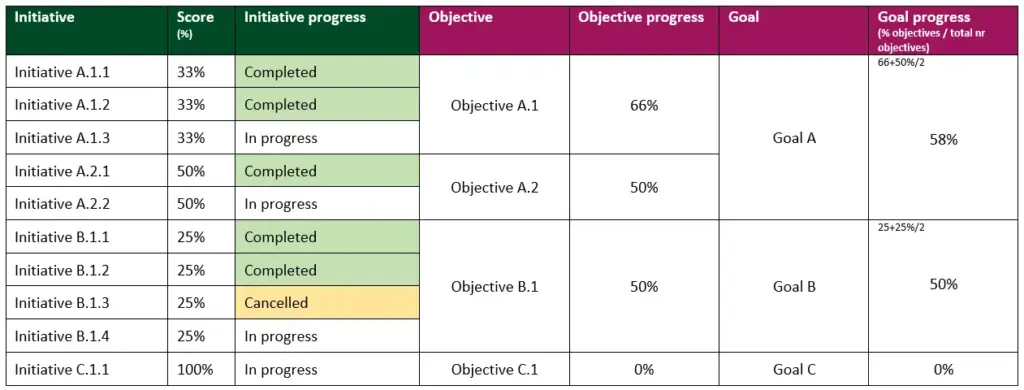In today’s rapidly changing business landscape, it’s not enough to have a great strategy. It is equally important to be able to execute it effectively. Being able to execute the organizational strategy creates business value. And that’s where Enterprise Architecture comes in. By leveraging Enterprise Architecture, for example, organizations can concentrate on strategy execution. This allows them to connect their strategic objectives and the day-to-day operations that bring those objectives to life.
Strategy formulation
Now, the creation of a business strategy is one of the most important ways to allocate resources within an organization to achieve specific goals. Strategy formulation addresses aspects of organizational motivation such as vision, mission, and goals. Strategy builds on an organization’s drivers to provide an actionable path for achieving some or all of its goals.
So, how do we get to strategy execution?
Five phases of strategy execution
If we look at the process of strategy formulation and implementation, we can distinguish five phases.

- Determine strategy. Strategy development consists of identifying drivers, goals, and objectives. Enterprise Architecture plays an important role in understanding the impact of the chosen strategy on the organization. Defining a strategy is part the second stage of the Enterprise Architecture Implementation Wheel, Define.
- Designate change. Identifying the changes needed to implement the strategy characterizes this step. Enterprise Architecture is used to further interpret and decompose the changes, and to plan initiatives across the organization. Taking stock of the organization is described in the first stage of the Implementation Wheel, Document.
- Determine roadmap. An architecture roadmap uses the captured initiatives. In this step, the Enterprise Architecture is used to shape the required initiatives, grouping and arranging them so that they can be used in a roadmap. Creating a roadmap with the required initiatives is part of the third stage of the Enterprise Architecture Implementation Wheel, namely Execute.
- Develop solutions. The fourth step in the strategy to execution process is the development of solutions. Enterprise Architecture is not (directly) involved in designing solutions. That role is reserved for Solution Architecture. What is important in this step is to provide a framework so that a solution can be arrived at.
- Measure progress. Finally, measurable indicators are used to monitor the progress of strategy implementation. The fourth stage of the Enterprise Architecture Implementation Wheel, Control, explores this topic in more detail.
Now that we have named five phases of the strategy to execution process, we can zoom in on each phase separately.
Determine strategy
Identifying drivers, goals, and objectives is usually something that is done with the key stakeholders of an organization. However, as an Enterprise Architect, you can help formulate these elements correctly. It is important that the goals and associated objectives are formulated as SMART as possible. Goals and objectives need to be expressed in measurable terms. Phase 5, Measure progress, returns to the goals and objectives formulated in the Determine strategy phase. Without the specific and measurable formulation of the desired results, Phase 5 cannot be carried out properly.
Designate change
The second phase of the strategy execution process involves determining the impact of the proposed changes on the organization. Capabilities indicate what the impact of the intended changes will be on the organization and where – within which capability – it will be most noticeable. As such, capabilities are essential architectural elements on which many other things depend. Think, for example, of processes, actors, and applications.
In addition to capabilities, value streams also provide a picture of what an organization does. Value streams are the set of activities that add value to a product or service from the customer’s perspective. Value streams are different from business processes because processes do not have the customer’s perspective in mind. In a previous blog, I explained the differences between the value stream and business process concepts.
Determine roadmap
Initiatives are groups (or clusters) of activities. Thus, initiatives are more abstract than activities, whereas courses of action are one step more abstract than initiatives. Initiatives also produce deliverables, but these are less tangible than the deliverables of activities. Courses of action go one step further and chart a course to be followed (hence the name), rather than presenting an actual deliverable as a result. Courses of action often are a collection of one or more initiatives.
Because of their abstract form, are ideal for inclusion in a roadmap. Initiatives are sufficiently granular to make sense of what they are about without getting bogged down in details that do not belong in a roadmap. Incorporating initiatives into a roadmap yields the best results and gives senior management more than enough freedom to monitor progress. A roadmap shows which initiatives are related to which goals or objectives. A roadmap can be used to monitor the progress of the implementation of the organization’s strategy.
Develop solutions
Enterprise Architecture is not (directly) involved in designing and developing solutions given that this is something that is reserved for Solution Architects. What Enterprise Architecture can add at this stage is the provisioning of frameworks that can be used to help design solutions. This includes, for example, the development of architectural principles, requirements and standards.
Measure progress
As pointed out in the first phase of the strategy execution process, making sure that goals as well as objectives are defined in a measurable way is essential for this phase to succeed. Measuring the progress of goals, objectives, and initiatives can be made as complex as possible. However, it can quickly become cluttered, which gets in the way of insight. That is why I advocate a simple approach.
For example, if a goal consists of four objectives, it is recommended to assign a proportional percentage to each objective. This percentage represents the proportion that an objective has within the context of the goal. In this example, each of the four objectives has a weight of 25%. If an objective is satisfactorily achieved, then a quarter of the goal has been achieved.
Piecing it all together
The example of assigning percentages are detailed in the table below. It shows that Initiatives A.1.1 through A.2.2 are related to Goal A (via Objectives A.1 and A.2).

We can see in the table that Initiatives A.1.1 and A.1.2 have been implemented. To illustrate, each of the initiatives accounts for 33% of the achievement of Objective A.1. Together, the two implemented initiatives account for approximately 66% of the achievement of Objective A1. The table also shows that Initiative A.2.1 has been implemented, unlike Initiative A.2.2. Since only these two initiatives are defined in Objective A.2, we can say that Objective A.2 is 50% achieved.
The percentages of the two objectives (A.1 and A.2) together, divided by the total number of objectives (two in this case), gives a percentage that counts as the achievement percentage of Goal A. In this example, 66% + 50% / 2 = 58%.
Summing it all up
In conclusion, Enterprise Architecture can play a critical role in strategy execution. By developing a comprehensive understanding of the organization’s people, processes, information, and technology, Enterprise Architects can identify areas where improvements can be made to better align with the organization’s strategic objectives. From there, they can assist with the development of solutions that bridge those gaps.
Enterprise Architects can enable the organization to execute its strategy more effectively. Whether we’re talking about a small business or a large multinational corporation, Enterprise Architecture can help an organization achieve its goals and stay ahead in today’s rapidly changing business landscape.
Let me know what your thoughts are on this topic by leaving a comment below.







Leave a Reply